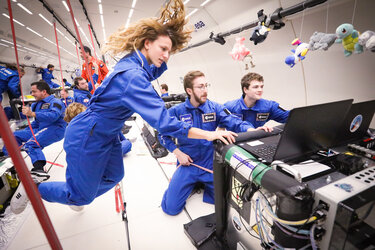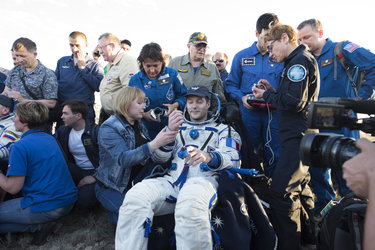ESA Academy’s first training course on Human Space Physiology a success
What’s it like to live in space? And what happens to the human body in microgravity? Thirty-six university students from fourteen different countries discussed these important themes last week in the first training course on Human Space Physiology offered by ESA’s Education and Space Medicine Offices.
Students from a range of academic backgrounds and levels took part in this innovative course which took place in two locations simultaneously: ESA’s Training and Learning Centre in Redu, Belgium, and ESA’s European Astronaut Centre in Cologne, Germany. Experts were present in both centres, and lectures were attended by all, either face-to-face or via videoconference.
One of the experts much appreciated by the students was ESA astronaut Reinhold Ewald, who inspired the students with his personal story of living in space. Participants also stated how valuable it was to learn from leading experts in the field of space physiology.

During the four-day course, fourteen European experts talked to the students about the challenges, lessons, and successes that have led to the permanent occupation of the International Space Station (ISS), as well as the extensive human space physiological research performed both on Earth and in space. How a number of the key physiological systems respond to microgravity, as well as the mechanisms that underlie these changes, were explored in detail.
Group projects were also an important part of the course. Teams of 4 or 5 students worked together on different ‘hot’ topics including: how female and male astronaut health may differ in space, the implications of having older astronauts take part in long-term missions, and the benefits and challenges associated with human-based surface exploration of a celestial body compared to a robotic mission.
“We’ve learned so much in these four days… not just from experts, but from each other too! Before this week I was captivated and intrigued by spaceflight and physiology, but now I’m even more convinced than ever to pursue a career in this field!”
Following the success of the course, ESA’s Education and Space Medicine Offices are hoping to offer the opportunity once again at the beginning of 2018 in order to allow more students to learn from, and be inspired by European expertise in human space physiology.
In addition, ESA’s Training and Learning Centre is offering several other training courses in different fields of ESA expertise, such as Standardisation, Product Assurance and Safety, Space Law, and Gravity-related Research later in 2017. Calls for applications will be published in the upcoming weeks… stay tuned!






